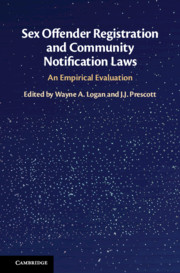Book contents
- Sex Offender Registration and Community Notification Laws: An Empirical Evaluation
- Sex Offender Registration and Community Notification Laws
- Copyright page
- Contents
- Contributors
- Preface
- Acknowledgments
- 1 Origins and Evolution
- 2 Variations in the Structure and Operation of SORN Systems
- 3 Registries and Registrants:
- 4 Law Enforcement and SORN
- 5 The Public and SORN Laws
- 6 The Ancillary Consequences of SORN
- 7 Offenders and SORN Laws
- 8 Integrating the Etiology of Sexual Offending into Evidence-Based Policy and Practices
- 9 Juvenile Registration and Notification Are Failed Policies That Must End
- Conclusion
- Index
- References
4 - Law Enforcement and SORN
Published online by Cambridge University Press: 11 June 2021
- Sex Offender Registration and Community Notification Laws: An Empirical Evaluation
- Sex Offender Registration and Community Notification Laws
- Copyright page
- Contents
- Contributors
- Preface
- Acknowledgments
- 1 Origins and Evolution
- 2 Variations in the Structure and Operation of SORN Systems
- 3 Registries and Registrants:
- 4 Law Enforcement and SORN
- 5 The Public and SORN Laws
- 6 The Ancillary Consequences of SORN
- 7 Offenders and SORN Laws
- 8 Integrating the Etiology of Sexual Offending into Evidence-Based Policy and Practices
- 9 Juvenile Registration and Notification Are Failed Policies That Must End
- Conclusion
- Index
- References
Summary
Chapter 4 discusses the relationship between SORN laws and law enforcement. Since the inception of SORN laws, proponents of registration and notification have viewed them as tools for effective law enforcement. The significant financial costs to maintain and enforce these laws, however, may outweigh any usefulness they offer to law enforcement in terms of reducing sex offense victimization. The chapter first describes how states implement SORN laws. State and local law enforcement agencies are charged with the initial registration of covered individuals. Thereafter, these agencies monitor registrants and facilitate community notification. They conduct unannounced visits, maintain online registries, and inform community groups. These tasks impose substantial costs on the police, diverting resources from other criminal justice priorities. Many agencies form specialized units for SORN enforcement; others outsource aspects to private, for-profit companies. The chapter next analyzes how law enforcement personnel perceive SORN laws – in particular, their effectiveness. Studies show that individuals in law enforcement often doubt the efficacy of registration and notification, despite consistently supporting them. Law enforcement agents also recognize the costs SORN laws carry for their agencies and priorities. Ultimately, this chapter questions whether SORN laws are worth the costly burdens they impose on law enforcement.
Keywords
- Type
- Chapter
- Information
- Sex Offender Registration and Community Notification LawsAn Empirical Evaluation, pp. 48 - 58Publisher: Cambridge University PressPrint publication year: 2021



